check engine JEEP COMPASS 2021 Owner handbook (in English)
[x] Cancel search | Manufacturer: JEEP, Model Year: 2021, Model line: COMPASS, Model: JEEP COMPASS 2021Pages: 328, PDF Size: 8.85 MB
Page 220 of 328

SERVICING AND MAINTENANCE
218
Once A Month Or Before A Long Trip
Check engine oil level.
Check windshield washer fluid level.
Check tire pressure and look for unusual
wear or damage. Rotate tires at the first
sign of irregular wear, even if it occurs
before the oil indicator system turns on.
Check the fluid levels of the coolant reser-
voir and brake master cylinder, fill as
needed.
Check function of all interior and exterior
lights.
Control and recovery of additive level for
AdBlue® Diesel emissions (UREA) (if
equipped). At Each Oil Change
Change the engine oil filter.
Inspect the brake hoses and lines.
Inspect for the presence of water in the
fuel filter/water separator unit.
Inspect air cleaner filter if using in dusty
or off-road conditions. Replace air cleaner
filter, if necessary.
Demanding Vehicle Use
Restore additive level for AdBlue® Diesel
emissions (UREA) (if equipped), when the
lamp is illuminated or the message on the
instrument panel.
Maintenance Plan — Diesel Engines
NOTE:
Once you have carried out the last interven -
tion in the table, continue with the sched -
uled servicing, maintaining the frequency
indicated in the plan by marking each oper -
ation with a dot or dedicated note. Simply
restarting the maintenance from the start of
the plan may cause the allowed interval to be
exceeded for some operations.
CAUTION!
Failure to perform the required
maintenance items may result in damage
to the vehicle.
2020_JEEP_M6_UG_UK.book Page 218
Page 221 of 328

219
Mileage or time passed (whichever comes
first)
12,000
24,000
36,000
48,000
60,000
72,000
84,000
96,000
108,000
120,000
132,000
144,000
156,000
168,000
180,000
Or Years: 1 2 3 4 5 6 7 8 9 10 11 12 13 14 15
Or Kilometers:
20,000
40,000
60,000
80,000
100,000
120,000
140,000
160,000
180,000
200,000
220,000
240,000
260,000
280,000
300,000
Additional Inspections
Change the engine oil and engine oil filter. (*)
Inspect the CV joints. X X X X X X X
Inspect front suspension, boot seals, tie rod
ends, and replace if necessary. X X X X X X X
Visually inspect condition of: exterior bodywork,
underbody protection, pipes and hoses (exhaust
- fuel system - brakes), rubber elements (boots,
sleeves, bushings, etc.). X X X X X X X
If using your vehicle in dusty or off-road
conditions, inspect the air cleaner filter, and
replace if necessary. X X X X X X X X X X X X X X X
Inspect the brake linings, replace if necessary. X X X X X X X Check and, if necessary, top up fluid levels. (°) X X X X X X X X X X X X X X X
Additional Maintenance
Replace engine air cleaner filter. X X X X X X X
Replace air conditioning/cabin air filter. X X X X X X X
2020_JEEP_M6_UG_UK.book Page 219
Page 227 of 328

225
(Continued)
Checking Oil Level
To assure proper engine lubrication, the
engine oil must be maintained at the correct
level. Check the oil level at regular intervals,
such as every fuel stop. The best time to
check the engine oil level is about five
minutes after a fully warmed up engine is
shut off.
Checking the oil while the vehicle is on level
ground will improve the accuracy of the oil
level readings.
There are three possible dipstick types,
Crosshatched zone.
Crosshatched zone marked SAFE.
Crosshatched zone marked with MIN at
the low end of the range and MAX at the
high end of the range.
Crosshatched zone marked with dimples
at the MIN and the MAX ends of the range.
NOTE:
Always maintain the oil level within the
crosshatch markings on the dipstick.
Adding 1 quart (1.0 liters) of oil when the
reading is at the low end of the dipstick
range will raise the oil level to the high end
of the range marking.
Adding Washer Fluid
The fluid reservoir is located in the front of
the engine compartment. Be sure to check
the fluid level in the reservoir at regular inter -
vals. Fill the reservoir with windshield washer
solvent (not radiator antifreeze) and operate
the system for a few seconds to flush out the
residual washer fluid.
When refilling the washer fluid reservoir,
take some washer fluid, apply it to a cloth or
towel, and wipe clean the wiper blades; this
will help blade performance.
WARNING!
Never smoke while working in the engine
compartment: gas and inflammable
vapors may be present, with the risk of
fire.
Be very careful when working in the
engine compartment when the engine is
hot: you may get burned. Do not get too
close to the radiator cooling fan: the
electric fan may start; danger of injury.
Scarves, ties and other loose clothing
might be pulled by moving parts.
CAUTION!
Be careful not to confuse the various
types of fluids while topping up: they are
not compatible with each other! Topping
up with an unsuitable fluid could
severely damage your car.
The oil level must never exceed the MAX
mark.
Always top up using engine oil of the
same specifications as that already in
the engine.
If the engine oil is being topped up, wait
for the engine to cool down before loos-
ening the filler cap, particularly for vehi -
cles with aluminium cap (if equipped).
WARNING: risk of burns!
Overfilling or underfilling the crankcase
will cause aeration or loss of oil pressure.
This could damage your engine.
CAUTION! (Continued)
2020_JEEP_M6_UG_UK.book Page 225
Page 229 of 328
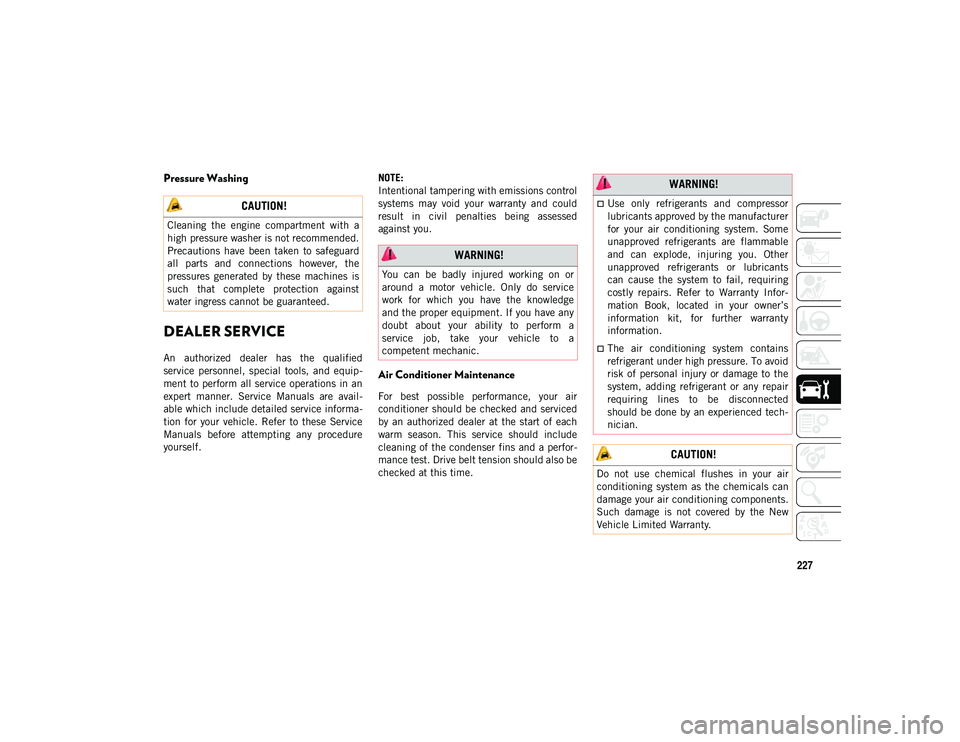
227
Pressure Washing
DEALER SERVICE
An authorized dealer has the qualified
service personnel, special tools, and equip-
ment to perform all service operations in an
expert manner. Service Manuals are avail -
able which include detailed service informa -
tion for your vehicle. Refer to these Service
Manuals before attempting any procedure
yourself. NOTE:
Intentional tampering with emissions control
systems may void your warranty and could
result in civil penalties being assessed
against you.
Air Conditioner Maintenance
For best possible performance, your air
conditioner should be checked and serviced
by an authorized dealer at the start of each
warm season. This service should include
cleaning of the condenser fins and a perfor
-
mance test. Drive belt tension should also be
checked at this time.
CAUTION!
Cleaning the engine compartment with a
high pressure washer is not recommended.
Precautions have been taken to safeguard
all parts and connections however, the
pressures generated by these machines is
such that complete protection against
water ingress cannot be guaranteed.
WARNING!
You can be badly injured working on or
around a motor vehicle. Only do service
work for which you have the knowledge
and the proper equipment. If you have any
doubt about your ability to perform a
service job, take your vehicle to a
competent mechanic.
WARNING!
Use only refrigerants and compressor
lubricants approved by the manufacturer
for your air conditioning system. Some
unapproved refrigerants are flammable
and can explode, injuring you. Other
unapproved refrigerants or lubricants
can cause the system to fail, requiring
costly repairs. Refer to Warranty Infor -
mation Book, located in your owner’s
information kit, for further warranty
information.
The air conditioning system contains
refrigerant under high pressure. To avoid
risk of personal injury or damage to the
system, adding refrigerant or any repair
requiring lines to be disconnected
should be done by an experienced tech -
nician.
CAUTION!
Do not use chemical flushes in your air
conditioning system as the chemicals can
damage your air conditioning components.
Such damage is not covered by the New
Vehicle Limited Warranty.
2020_JEEP_M6_UG_UK.book Page 227
Page 231 of 328
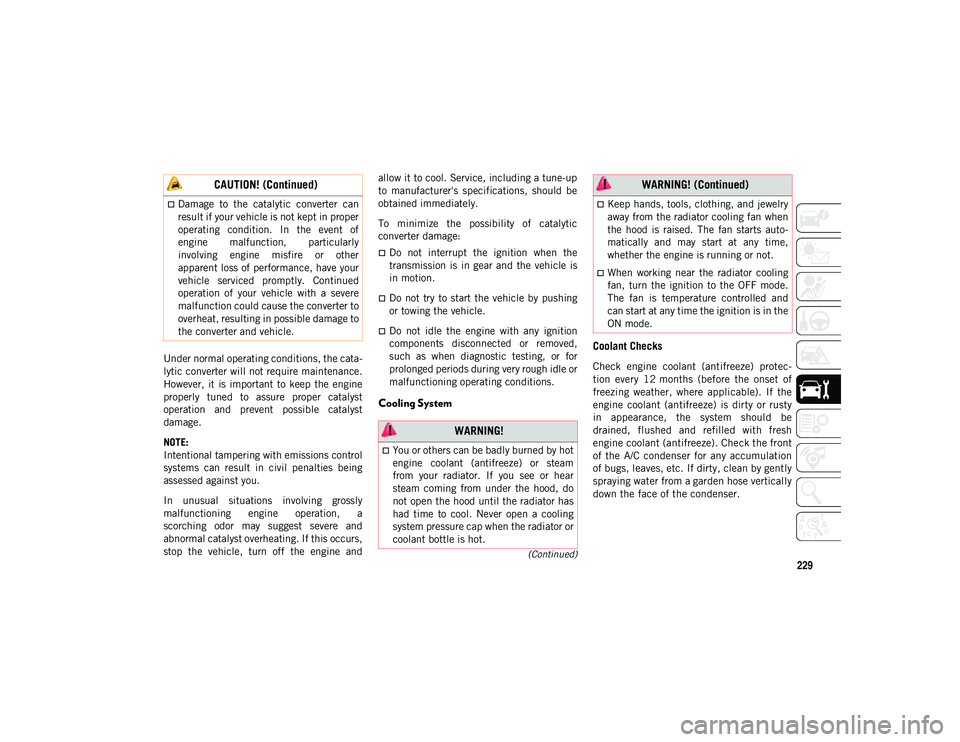
229(Continued)
Under normal operating conditions, the cata-
lytic converter will not require maintenance.
However, it is important to keep the engine
properly tuned to assure proper catalyst
operation and prevent possible catalyst
damage.
NOTE:
Intentional tampering with emissions control
systems can result in civil penalties being
assessed against you.
In unusual situations involving grossly
malfunctioning engine operation, a
scorching odor may suggest severe and
abnormal catalyst overheating. If this occurs,
stop the vehicle, turn off the engine and allow it to cool. Service, including a tune-up
to manufacturer's specifications, should be
obtained immediately.
To minimize the possibility of catalytic
converter damage:
Do not interrupt the ignition when the
transmission is in gear and the vehicle is
in motion.
Do not try to start the vehicle by pushing
or towing the vehicle.
Do not idle the engine with any ignition
components disconnected or removed,
such as when diagnostic testing, or for
prolonged periods during very rough idle or
malfunctioning operating conditions.
Cooling System
Coolant Checks
Check engine coolant (antifreeze) protec
-
tion every 12 months (before the onset of
freezing weather, where applicable). If the
engine coolant (antifreeze) is dirty or rusty
in appearance, the system should be
drained, flushed and refilled with fresh
engine coolant (antifreeze). Check the front
of the A/C condenser for any accumulation
of bugs, leaves, etc. If dirty, clean by gently
spraying water from a garden hose vertically
down the face of the condenser.
Damage to the catalytic converter can
result if your vehicle is not kept in proper
operating condition. In the event of
engine malfunction, particularly
involving engine misfire or other
apparent loss of performance, have your
vehicle serviced promptly. Continued
operation of your vehicle with a severe
malfunction could cause the converter to
overheat, resulting in possible damage to
the converter and vehicle.
CAUTION! (Continued)
WARNING!
You or others can be badly burned by hot
engine coolant (antifreeze) or steam
from your radiator. If you see or hear
steam coming from under the hood, do
not open the hood until the radiator has
had time to cool. Never open a cooling
system pressure cap when the radiator or
coolant bottle is hot.
Keep hands, tools, clothing, and jewelry
away from the radiator cooling fan when
the hood is raised. The fan starts auto-
matically and may start at any time,
whether the engine is running or not.
When working near the radiator cooling
fan, turn the ignition to the OFF mode.
The fan is temperature controlled and
can start at any time the ignition is in the
ON mode.
WARNING! (Continued)
2020_JEEP_M6_UG_UK.book Page 229
Page 232 of 328

SERVICING AND MAINTENANCE
230
(Continued)
Cooling System Pressure Cap
The cap must be fully tightened to prevent
loss of engine coolant (antifreeze), and to
ensure that engine coolant (antifreeze) will
return to the radiator from the coolant expan-
sion bottle/recovery tank if so equipped.
The cap should be inspected and cleaned if
there is any accumulation of foreign material
on the sealing surfaces.
Brake System
In order to assure brake system performance,
all brake system components should be
inspected periodically. Refer to the “Mainte -nance Plan” in this section for the proper
maintenance intervals.
Brake Master Cylinder
The fluid in the master cylinder should be
checked when performing under hood
services or immediately if the “Brake
Warning Light” is illuminated.
Be sure to clean the top of the master
cylinder area before removing the cap. If
necessary, add fluid to bring the fluid level
up to the requirements described on the
brake fluid reservoir. With disc brakes, fluid
level can be expected to fall as the brake
pads wear. Brake fluid level should be
checked when pads are replaced. However,
low fluid level may be caused by a leak and
a checkup may be needed.
Use only manufacturer's recommended
brake fluid. Refer to “Fluids And Lubricants”
in “Technical Specifications” for further
information.
WARNING!
Do not open hot engine cooling system.
Never add engine coolant (antifreeze)
when the engine is overheated. Do not
loosen or remove the cap to cool an over
-
heated engine. Heat causes pressure to
build up in the cooling system. To
prevent scalding or injury, do not remove
the pressure cap while the system is hot
or under pressure.
Do not use a pressure cap other than the
one specified for your vehicle. Personal
injury or engine damage may result.
WARNING!
Riding the brakes can lead to brake failure
and possibly a collision. Driving with your
foot resting or riding on the brake pedal
can result in abnormally high brake
temperatures, excessive lining wear, and
possible brake damage. You would not
have your full braking capacity in an
emergency. WARNING!
Use only manufacturer's recommended
brake fluid. Refer to “Fluids And Lubri -
cants” in “Technical Specifications” for
further information. Using the wrong
type of brake fluid can severely damage
your brake system and/or impair its
performance. The proper type of brake
fluid for your vehicle is also identified on
the original factory installed hydraulic
master cylinder reservoir.
To avoid contamination from foreign
matter or moisture, use only new brake
fluid or fluid that has been in a tightly
closed container. Keep the master
cylinder reservoir cap secured at all
times. Brake fluid in a open container
absorbs moisture from the air resulting
in a lower boiling point. This may cause
it to boil unexpectedly during hard or
prolonged braking, resulting in sudden
brake failure. This could result in a colli -
sion.
2020_JEEP_M6_UG_UK.book Page 230
Page 233 of 328
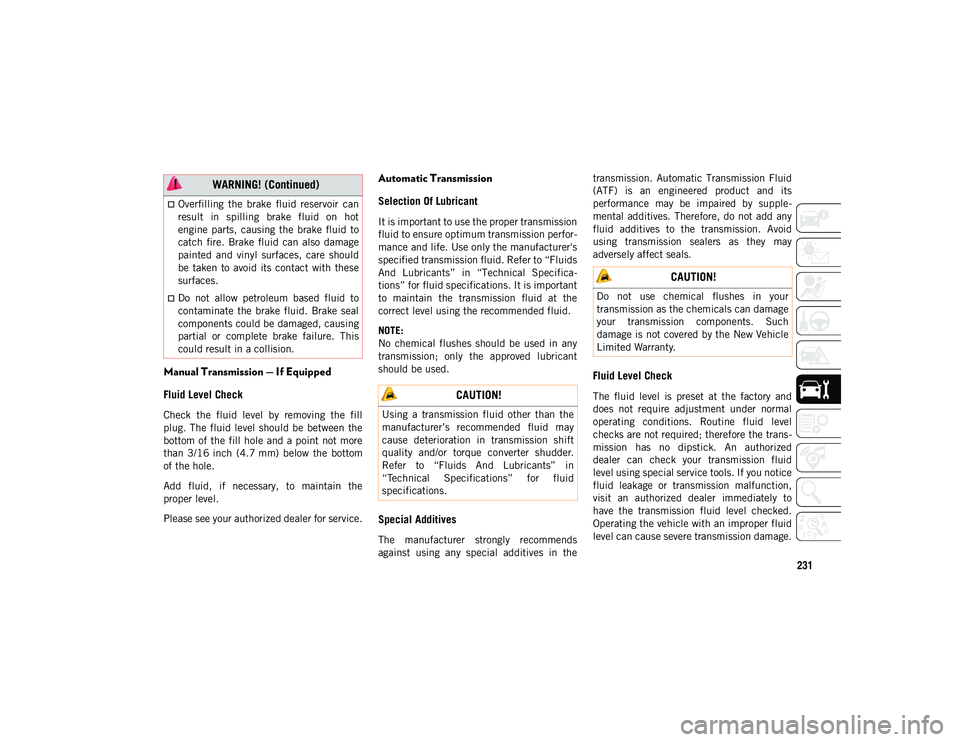
231
Manual Transmission — If Equipped
Fluid Level Check
Check the fluid level by removing the fill
plug. The fluid level should be between the
bottom of the fill hole and a point not more
than 3/16 inch (4.7 mm) below the bottom
of the hole.
Add fluid, if necessary, to maintain the
proper level.
Please see your authorized dealer for service.
Automatic Transmission
Selection Of Lubricant
It is important to use the proper transmission
fluid to ensure optimum transmission perfor-
mance and life. Use only the manufacturer's
specified transmission fluid. Refer to “Fluids
And Lubricants” in “Technical Specifica -
tions” for fluid specifications. It is important
to maintain the transmission fluid at the
correct level using the recommended fluid.
NOTE:
No chemical flushes should be used in any
transmission; only the approved lubricant
should be used.
Special Additives
The manufacturer strongly recommends
against using any special additives in the transmission. Automatic Transmission Fluid
(ATF) is an engineered product and its
performance may be impaired by supple
-
mental additives. Therefore, do not add any
fluid additives to the transmission. Avoid
using transmission sealers as they may
adversely affect seals.
Fluid Level Check
The fluid level is preset at the factory and
does not require adjustment under normal
operating conditions. Routine fluid level
checks are not required; therefore the trans -
mission has no dipstick. An authorized
dealer can check your transmission fluid
level using special service tools. If you notice
fluid leakage or transmission malfunction,
visit an authorized dealer immediately to
have the transmission fluid level checked.
Operating the vehicle with an improper fluid
level can cause severe transmission damage.
Overfilling the brake fluid reservoir can
result in spilling brake fluid on hot
engine parts, causing the brake fluid to
catch fire. Brake fluid can also damage
painted and vinyl surfaces, care should
be taken to avoid its contact with these
surfaces.
Do not allow petroleum based fluid to
contaminate the brake fluid. Brake seal
components could be damaged, causing
partial or complete brake failure. This
could result in a collision.
WARNING! (Continued)
CAUTION!
Using a transmission fluid other than the
manufacturer’s recommended fluid may
cause deterioration in transmission shift
quality and/or torque converter shudder.
Refer to “Fluids And Lubricants” in
“Technical Specifications” for fluid
specifications.
CAUTION!
Do not use chemical flushes in your
transmission as the chemicals can damage
your transmission components. Such
damage is not covered by the New Vehicle
Limited Warranty.
2020_JEEP_M6_UG_UK.book Page 231
Page 242 of 328
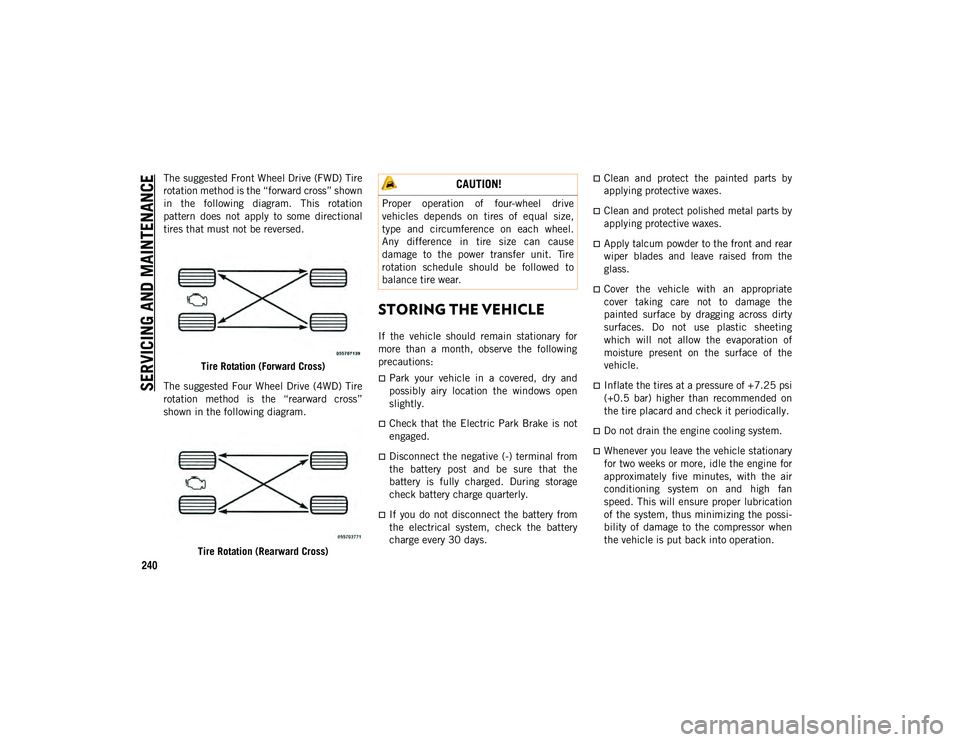
SERVICING AND MAINTENANCE
240
The suggested Front Wheel Drive (FWD) Tire
rotation method is the “forward cross” shown
in the following diagram. This rotation
pattern does not apply to some directional
tires that must not be reversed.Tire Rotation (Forward Cross)
The suggested Four Wheel Drive (4WD) Tire
rotation method is the “rearward cross”
shown in the following diagram.
Tire Rotation (Rearward Cross)
STORING THE VEHICLE
If the vehicle should remain stationary for
more than a month, observe the following
precautions:
Park your vehicle in a covered, dry and
possibly airy location the windows open
slightly.
Check that the Electric Park Brake is not
engaged.
Disconnect the negative (-) terminal from
the battery post and be sure that the
battery is fully charged. During storage
check battery charge quarterly.
If you do not disconnect the battery from
the electrical system, check the battery
charge every 30 days.
Clean and protect the painted parts by
applying protective waxes.
Clean and protect polished metal parts by
applying protective waxes.
Apply talcum powder to the front and rear
wiper blades and leave raised from the
glass.
Cover the vehicle with an appropriate
cover taking care not to damage the
painted surface by dragging across dirty
surfaces. Do not use plastic sheeting
which will not allow the evaporation of
moisture present on the surface of the
vehicle.
Inflate the tires at a pressure of +7.25 psi
(+0.5 bar) higher than recommended on
the tire placard and check it periodically.
Do not drain the engine cooling system.
Whenever you leave the vehicle stationary
for two weeks or more, idle the engine for
approximately five minutes, with the air
conditioning system on and high fan
speed. This will ensure proper lubrication
of the system, thus minimizing the possi -
bility of damage to the compressor when
the vehicle is put back into operation.
CAUTION!
Proper operation of four-wheel drive
vehicles depends on tires of equal size,
type and circumference on each wheel.
Any difference in tire size can cause
damage to the power transfer unit. Tire
rotation schedule should be followed to
balance tire wear.
2020_JEEP_M6_UG_UK.book Page 240
Page 286 of 328
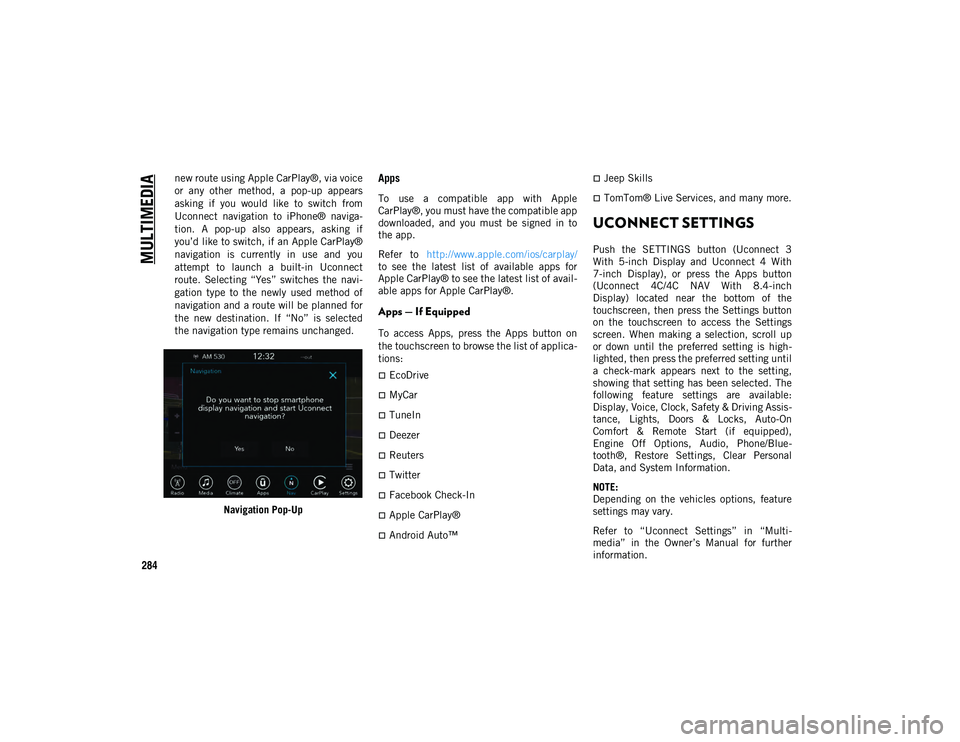
MULTIMEDIA
284
new route using Apple CarPlay®, via voice
or any other method, a pop-up appears
asking if you would like to switch from
Uconnect navigation to iPhone® naviga-
tion. A pop-up also appears, asking if
you’d like to switch, if an Apple CarPlay®
navigation is currently in use and you
attempt to launch a built-in Uconnect
route. Selecting “Yes” switches the navi-
gation type to the newly used method of
navigation and a route will be planned for
the new destination. If “No” is selected
the navigation type remains unchanged.
Navigation Pop-UpApps
To use a compatible app with Apple
CarPlay®, you must have the compatible app
downloaded, and you must be signed in to
the app.
Refer to http://www.apple.com/ios/carplay/
to see the latest list of available apps for
Apple CarPlay® to see the latest list of avail -
able apps for Apple CarPlay®.
Apps — If Equipped
To access Apps, press the Apps button on
the touchscreen to browse the list of applica -
tions:
EcoDrive
MyCar
TuneIn
Deezer
Reuters
Twitter
Facebook Check-In
Apple CarPlay®
Android Auto™
Jeep Skills
TomTom® Live Services, and many more.
UCONNECT SETTINGS
Push the SETTINGS button (Uconnect 3
With 5-inch Display and Uconnect 4 With
7-inch Display), or press the Apps button
(Uconnect 4C/4C NAV With 8.4-inch
Display) located near the bottom of the
touchscreen, then press the Settings button
on the touchscreen to access the Settings
screen. When making a selection, scroll up
or down until the preferred setting is high -
lighted, then press the preferred setting until
a check-mark appears next to the setting,
showing that setting has been selected. The
following feature settings are available:
Display, Voice, Clock, Safety & Driving Assis -
tance, Lights, Doors & Locks, Auto-On
Comfort & Remote Start (if equipped),
Engine Off Options, Audio, Phone/Blue -
tooth®, Restore Settings, Clear Personal
Data, and System Information.
NOTE:
Depending on the vehicles options, feature
settings may vary.
Refer to “Uconnect Settings” in “Multi -
media” in the Owner’s Manual for further
information.
2020_JEEP_M6_UG_UK.book Page 284
Page 319 of 328

317
INDEX
A
Accessories ....................................... 260Mopar ........................................... 260
Active Speed Limiter .......................... 149
Adaptive Cruise Control (ACC) (Cruise Con -
trol) .................................................. 151
Adding Fuel ...................................... 167
Additives, Fuel .................................. 250
Air Bag ............................................... 99 Air Bag Operation ........................... 101Air Bag Warning Light ....................... 98
Enhanced Accident Response .. 111 , 211
Event Data Recorder (EDR) ............. 211
If Deployment Occurs ..................... 110
Knee Impact Bolsters ..................... 107
Maintaining Your Air Bag System ..... 113
Maintenance .................................. 113
Redundant Air Bag Warning Light ...... 99
Side Air Bags ................................. 107
Transporting Pets ........................... 127
Air Bag Light ..........................59 , 98 , 129
Air Conditioner Maintenance ............... 227
Air Conditioner Refrigerant ................. 227
Air Conditioner System ....................... 227
Air Conditioning................................... 43
Air Conditioning Filter .................. 44 , 228
Air Conditioning, Operating Tips ............ 44 Air Pressure
Tires ............................................. 233
Alarm Arm The System .............................. 18
Disarm The System .......................... 18
Security Alarm ............................18 , 62
Alarm System Security Alarm ............................18 , 19
Android Auto..............................271 , 302
Antifreeze (Engine Coolant) ................ 254
Anti-Lock Brake System (ABS) .............. 72
Anti-Lock Warning Light ....................... 62
Apple CarPlay ............................272 , 303
Arming System Security Alarm ................................. 18
Assist, Hill Start .................................. 78
Audio Jack .................................270 , 276
Audio Systems (Radio) ................262 , 264
Auto Down Power Windows ................... 45
Auto Up Power Windows ...................... 45
Automatic Headlights .......................... 32
Automatic High Beams ........................ 32
Automatic Temperature Control (ATC) ... 43
Automatic Transaxle .......................... 139 Automatic Transmission......................140
Adding Fluid ..................................259
Fluid Level Check ...........................231
Fluid Type ............................. 231 , 259
Special Additives ............................231
Auxiliary (Power Outlet) ........................52
Auxiliary Electrical Outlet (Power
Outlet) ................................................52
Axle Lubrication .................................259
B
Battery ........................................ 60 , 226
Charging System Light ......................60
Belts, Seat ........................................128
Blind Spot Monitoring ..........................80
Brake Assist System ....................... 73 , 84
Brake Control System, Electronic ...........73
Brake Fluid .......................................259
Brake System ....................................230 Fluid Check ........................... 230 , 259
Master Cylinder ..............................230
Parking ..........................................134 Warning Light...................................59
Brake/Transmission Interlock...............140
Bulb Replacement .............................177
Bulbs, Light ......................................130
2020_JEEP_M6_UG_UK.book Page 317